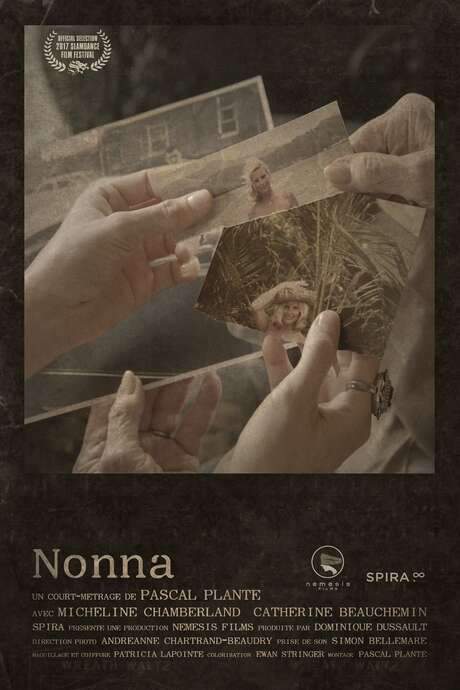
Nonna
Year: 2016
Runtime: 10 mins
Language: French
Director: Pascal Plante
A surprising visit at granny’s…
Warning: spoilers below!
Haven’t seen Nonna yet? This summary contains major spoilers. Bookmark the page, watch the movie, and come back for the full breakdown. If you're ready, scroll on and relive the story!
Nonna (2016) – Full Plot Summary & Ending Explained
Read the complete plot breakdown of Nonna (2016), including all key story events, major twists, and the ending explained in detail. Discover what really happened—and what it all means.
Grieving the loss of his mother, Joe Scaravella looks back on a Brooklyn childhood filled with the warm bustle of his mother Maria and his nonna in the kitchen, feeding friends and family in the 1970s. He recalls how they taught him to chase the comforting ritual of cooking, trying to recreate every dish they used to make. Yet one stubborn memory evades him: his nonna’s elusive Sunday gravy. The ache of that gap threads through his reflection as he attempts to honor their legacy through food.
At dinner with his best friend Bruno and Bruno’s wife Stella, the weight of bereavement shifts toward a practical plan. They urge Joe to use his mother’s life insurance to do something meaningful for himself, something that would honor their memories while giving him a chance to heal. A visit to a bustling open-air market on Staten Island jolts him further into action: he runs into Olivia, his long-ago crush, and Antonella, Olivia’s older neighbor who is shopping nearby. The encounter plants a seed that grows into a bold vision: open a restaurant in the market district, naming it Enoteca Maria after his mother, with a kitchen staffed by nonnas so the food could evoke the nostalgia of childhood for guests.
Undeterred by local skepticism and resistance from some Staten Island locals, Joe moves forward. He enlists Bruno as a contractor and breathes life into a tired space, transforming it into a classic Italian restaurant reminiscent of home. To run the kitchen, he brings on Antonella, his mother’s best friend Roberta, her former hairdresser Gia, and a walk-in hire named Teresa. The nonnas come from different backgrounds and temperaments, and initial tensions bubble up. But a private pampering session at Gia’s salon acts as a turning point: they open up, share deep stories of love, heartbreak, resilience, and loss, and slowly discover a shared bond that transcends generations and backgrounds.
As the nonnas begin shaping the menu, a kitchen mishap rattles the project. Roberta makes capuzzelle, unintentionally sparking a fire just before an inspection. The inspector’s negative verdict leaves the restaurant technically grounded, and he warns that a full reinspection could take a year. The setback triggers a confrontation between Joe and Bruno, culminating in Joe expelling Bruno from the venture. Later, Joe learns the weight of Bruno’s sacrifice: Bruno had sold his inherited car to cover ongoing costs. Seeing his friend’s generosity restores their bond, and the two reconcile in a quiet, renewed commitment to the dream.
Olivia, ever the determined advocate, begins to pull strings. She uncovers a troubling history behind the inspector—evidence of unethical practices—and convinces him to conduct a new inspection. The restaurant clears that hurdle, and the team starts to prepare for a real opening.
Opening night arrives amid a ferocious thunderstorm that keeps most patrons away. Only Bruno and Stella remain as witnesses to the first test of the concept. Antonella uncovers a troubling thread: a major vendor at the market has been disparaging the restaurant, contributing to the poor early reception. In an effort to generate buzz, Joe invites respected food critic Edward Durant to visit, but the critic declines, explaining that he only covers high-end Manhattan establishments.
Weeks pass with little business, and the temptation to close the doors grows stronger. As a last hurrah, Joe hosts a dinner gathering for friends and coworkers, a warm showcase of what Enoteca Maria has become. The night is a quiet triumph, and it prompts Joe to confront a box he has avoided since Maria’s passing: an envelope she left behind. Inside lie the treasured recipes for all of her dishes, including the long-sought Sunday gravy. Reading them, Joe feels the pull of the old life and the promise of the future.
Not long after, Bruno visits with a newspaper article about the restaurant. One attendee at the final dinner—an incognito critic sent by Durant—has written a glowing review that catches the attention of the dining public. The surge in interest is swift and dramatic, transforming Enoteca Maria into a thriving destination. Joe uses the momentum to buy back Bruno’s car, and a new chapter begins: Olivia and Joe start a relationship, blending romance with a reinvented family of cooks who have grown into a broader, shared vocation.
The credits exit with a nod to the real world: Enoteca Maria is celebrated as a living beacon of family cooking, open for 15 years and staffed by nonnas from around the world, each bringing their own heritage to the table. The film leaves a sense of how food, memory, and community can heal, rebuild, and sustain a dream that started in a kitchen and grew into something larger than anyone could have imagined.
Last Updated: October 03, 2025 at 06:47
Unlock the Full Story of Nonna
Don't stop at just watching — explore Nonna in full detail. From the complete plot summary and scene-by-scene timeline to character breakdowns, thematic analysis, and a deep dive into the ending — every page helps you truly understand what Nonna is all about. Plus, discover what's next after the movie.
Nonna Timeline
Track the full timeline of Nonna with every major event arranged chronologically. Perfect for decoding non-linear storytelling, flashbacks, or parallel narratives with a clear scene-by-scene breakdown.

Characters, Settings & Themes in Nonna
Discover the characters, locations, and core themes that shape Nonna. Get insights into symbolic elements, setting significance, and deeper narrative meaning — ideal for thematic analysis and movie breakdowns.



